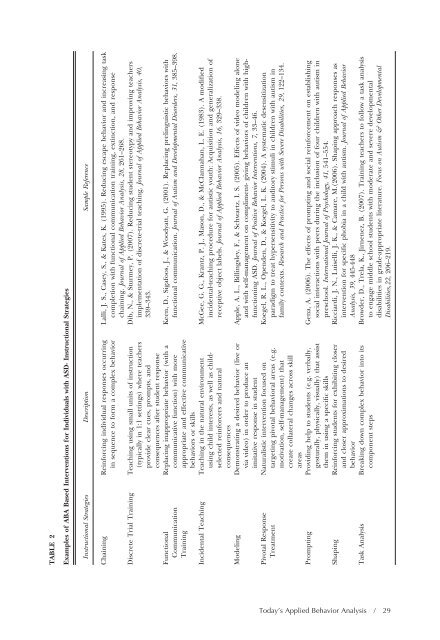Beyond Time Out and Table Time - Division on Autism and ...
Beyond Time Out and Table Time - Division on Autism and ...
Beyond Time Out and Table Time - Division on Autism and ...
Create successful ePaper yourself
Turn your PDF publications into a flip-book with our unique Google optimized e-Paper software.
TABLE 2<br />
Examples of ABA Based Interventi<strong>on</strong>s for Individuals with ASD- Instructi<strong>on</strong>al Strategies<br />
Instructi<strong>on</strong>al Strategies Descripti<strong>on</strong> Sample Reference<br />
Lalli, J. S., Casey, S., & Kates, K. (1995). Reducing escape behavior <str<strong>on</strong>g>and</str<strong>on</strong>g> increasing task<br />
completi<strong>on</strong> with functi<strong>on</strong>al communicati<strong>on</strong> training, extincti<strong>on</strong>, <str<strong>on</strong>g>and</str<strong>on</strong>g> resp<strong>on</strong>se<br />
chaining. Journal of Applied Behavior Analysis, 28, 261–268.<br />
Dib, N., & Sturmey, P. (2007). Reducing student stereotypy <str<strong>on</strong>g>and</str<strong>on</strong>g> improving teachers<br />
implementati<strong>on</strong> of discrete-trial teaching. Journal of Applied Behavior Analysis, 40,<br />
339–343.<br />
Chaining Reinforcing individual resp<strong>on</strong>ses occurring<br />
in sequence to form a complex behavior<br />
Keen, D., Sigafoos, J., & Woodyatt, G. (2001). Replacing prelinguistic behaviors with<br />
functi<strong>on</strong>al communicati<strong>on</strong>. Journal of <strong>Autism</strong> <str<strong>on</strong>g>and</str<strong>on</strong>g> Developmental Disorders, 31, 385–398.<br />
McGee, G. G., Krantz, P. J., Mas<strong>on</strong>, D., & McClannahan, L. E. (1983). A modified<br />
incidental-teaching procedure for autistic youth: Acquisiti<strong>on</strong> <str<strong>on</strong>g>and</str<strong>on</strong>g> generalizati<strong>on</strong> of<br />
receptive object labels. Journal of Applied Behavior Analysis, 16, 329–338.<br />
Apple, A. L., Billingsley, F., & Schwartz, I. S. (2005). Effects of video modeling al<strong>on</strong>e<br />
<str<strong>on</strong>g>and</str<strong>on</strong>g> with self-management <strong>on</strong> compliment- giving behaviors of children with highfuncti<strong>on</strong>ing<br />
ASD. Journal of Positive Behavior Interventi<strong>on</strong>s, 7, 33–46.<br />
Koegel, R. L., Openden, D., & Koegel, L. K. (2004). A systematic desensitizati<strong>on</strong><br />
paradigm to treat hypersensitivity to auditory stimuli in children with autism in<br />
family c<strong>on</strong>texts. Research <str<strong>on</strong>g>and</str<strong>on</strong>g> Practice for Pers<strong>on</strong>s with Severe Disabilities, 29, 122–134.<br />
Gena, A. (2006). The effects of prompting <str<strong>on</strong>g>and</str<strong>on</strong>g> social reinforcement <strong>on</strong> establishing<br />
social interacti<strong>on</strong>s with peers during the inclusi<strong>on</strong> of four children with autism in<br />
preschool. Internati<strong>on</strong>al Journal of Psychology, 41, 541–554.<br />
Ricciardi, J. N., Luiselli, J. K., & Camare, M.(2006). Shaping approach resp<strong>on</strong>ses as<br />
interventi<strong>on</strong> for specific phobia in a child with autism. Journal of Applied Behavior<br />
Analysis, 39, 445-448<br />
Browder, D., Trela, K., Jirnenez, B. (2007). Training teachers to follow a task analysis<br />
to engage middle school students with moderate <str<strong>on</strong>g>and</str<strong>on</strong>g> severe developmental<br />
disabilities in grade-appropriate literature. Focus <strong>on</strong> <strong>Autism</strong> & Other Developmental<br />
Disabilities,22, 206–219.<br />
Discrete Trial Training Teaching using small units of instructi<strong>on</strong><br />
(typically in 1:1 settings) where teachers<br />
provide clear cues, prompts, <str<strong>on</strong>g>and</str<strong>on</strong>g><br />
c<strong>on</strong>sequences after student resp<strong>on</strong>se<br />
Functi<strong>on</strong>al<br />
Replacing inappropriate behavior (with a<br />
Communicati<strong>on</strong><br />
communicative functi<strong>on</strong>) with more<br />
Training<br />
appropriate <str<strong>on</strong>g>and</str<strong>on</strong>g> effective communicative<br />
behaviors or skills<br />
Incidental Teaching Teaching in the natural envir<strong>on</strong>ment<br />
using child interests, as well as childselected<br />
reinforcers <str<strong>on</strong>g>and</str<strong>on</strong>g> natural<br />
c<strong>on</strong>sequences<br />
Modeling Dem<strong>on</strong>strating a desired behavior (live or<br />
via video) in order to produce an<br />
imitative resp<strong>on</strong>se in student<br />
Pivotal Resp<strong>on</strong>se<br />
Naturalistic interventi<strong>on</strong> focused <strong>on</strong><br />
Treatment<br />
targeting pivotal behavioral areas (e.g.<br />
motivati<strong>on</strong>, self-management) that<br />
create collateral changes across skill<br />
areas<br />
Prompting Providing help to students (e.g. verbally,<br />
gesturally, physically, visually) that assist<br />
them in using a specific skills<br />
Shaping Reinforcing students for exhibiting closer<br />
<str<strong>on</strong>g>and</str<strong>on</strong>g> closer approximati<strong>on</strong>s to desired<br />
behavior<br />
Task Analysis Breaking down complex behavior into its<br />
comp<strong>on</strong>ent steps<br />
Today’s Applied Behavior Analysis / 29
















